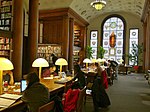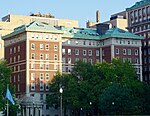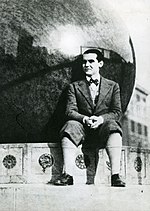Hamilton Hall (Columbia University)

Hamilton Hall is an academic building on the Morningside Heights campus of Columbia University on College Walk (116th Street) at 1130 Amsterdam Avenue in Manhattan, New York City. It was built in 1905–1907 and was designed by McKim, Mead & White in the Neoclassical style; the building was part of the firm's original master plan for the campus. The building was the gift of the John Stewart Kennedy, a former trustee of Columbia College, and is named after Alexander Hamilton, who attended King's College, Columbia's original name. A statue of Hamilton by William Ordway Partridge stands outside the building entrance. Hamilton Hall is the location of the Columbia College administrative offices.
Excerpt from the Wikipedia article Hamilton Hall (Columbia University) (License: CC BY-SA 3.0, Authors, Images).Hamilton Hall (Columbia University)
Low Library Steps, New York Manhattan
Geographical coordinates (GPS) Address Website Nearby Places Show on map
Geographical coordinates (GPS)
| Latitude | Longitude |
|---|---|
| N 40.80685 ° | E -73.961705555556 ° |
Address
Columbia University (Columbia University in the City of New York)
Low Library Steps
10027 New York, Manhattan
New York, United States
Open on Google Maps








